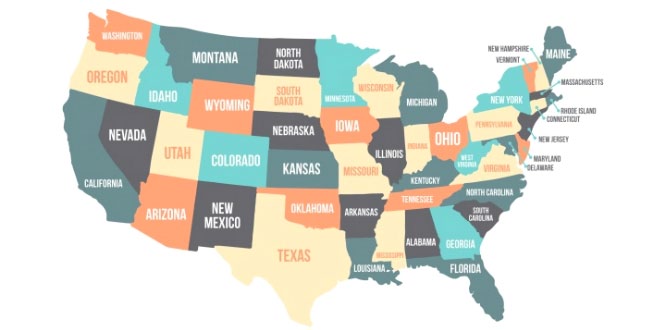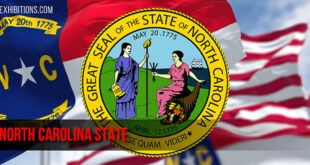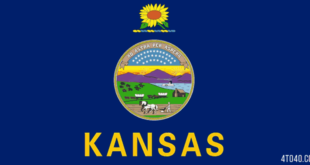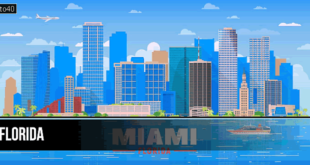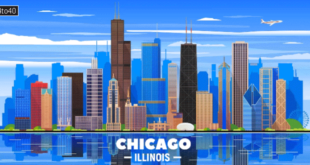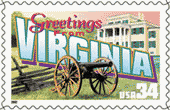 Named for Elizabeth I, England’s “Virgin Queen”, the state is also known as the Old Dominion–in recognition of the decision of Charles II to make the colony a fourth dominion of his realm, after England, Scotland, and Ireland–and as the Mother of Presidents, because it is the birthplace of eight U.S. presidents (George Washington, Thomas Jefferson, James Madison, James Monroe, William Henry Harrison, John Tyler, Zachary Taylor, and Woodrow Wilson).
Named for Elizabeth I, England’s “Virgin Queen”, the state is also known as the Old Dominion–in recognition of the decision of Charles II to make the colony a fourth dominion of his realm, after England, Scotland, and Ireland–and as the Mother of Presidents, because it is the birthplace of eight U.S. presidents (George Washington, Thomas Jefferson, James Madison, James Monroe, William Henry Harrison, John Tyler, Zachary Taylor, and Woodrow Wilson).
Officially called the Commonwealth of Virginia, the state forms a rough triangle, with North Carolina and Tennessee to the south; Maryland, Chesapeake Bay, and the Atlantic Ocean to the northeast and east; and West Virginia and Kentucky to the northwest and west. Founded in 1607, Jamestown, near the southeastern corner of the state, represents the first permanent English settlement in North America. Virginia State played a pivotal role in the American Revolution and the Civil War.
Virginia State: Land & Resources
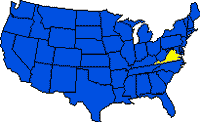 Virginia has five distinctive topographical regions. Moving in from the Atlantic coast, the Tidewater, or coastal plain, is succeeded by the Piedmont or PIEDMONT PLATEAU, the BLUE RIDGE MOUNTAINS, the ridge and valley region, and the CUMBERLAND PLATEAU. The last three are part of the APPALACHIAN MOUNTAINS.
Virginia has five distinctive topographical regions. Moving in from the Atlantic coast, the Tidewater, or coastal plain, is succeeded by the Piedmont or PIEDMONT PLATEAU, the BLUE RIDGE MOUNTAINS, the ridge and valley region, and the CUMBERLAND PLATEAU. The last three are part of the APPALACHIAN MOUNTAINS.
Tidewater Virginia, including the Eastern Shore–the southern tip of the DELMARVA PENINSULA separated from the remainder of the state by CHESAPEAKE BAY–is generally low-lying and sandy, rising to about 90 m (300 ft) as it meets the Piedmont. Broad estuaries divide the western Tidewater into a series of peninsulas reaching into the bay.
The rolling hills of Piedmont Virginia extend southwest from Alexandria in the north. The towns of Fredericksburg, Richmond, and Emporia lie on the FALL LINE. The region widens from 65 km (40 mi) at the Potomac to about 260 km (160 mi) at the North Carolina line. The continuous Blue Ridge of Precambrian rock rises from about 300 m (1,000 ft) at its base at the western edge of the Piedmont, reaching elevations of 350 m (1,200 ft) in the north to more than 1,700 m (5,500 ft) in the south. Virginia’s highest point, Mount Rodgers, is found in the wider southern portion of the mountains.
The ridge and valley section of the state begins with the limestone-floored Great Valley and continues to the West Virginia border with a series of elongated hills and valleys trending northeast-southwest. In the extreme southwestern portion of Virginia lies a small part of the Cumberland Plateau of Kentucky at an average elevation of 840 m (2,750 ft).
Climate
Virginia has a temperate climate; although summers are hot, winters are mild, and precipitation occurs throughout the year. Elevation is the primary climatic determinant. July temperatures average 21 deg C (70 deg F) in the southwestern mountains but 27 deg C (80 deg F) in the southern Tidewater. In January the statewide average temperature drops to 4 deg C (39 deg F). The frost-free growing season varies from 140 days in the Appalachian foothills to 250 days along the Atlantic Ocean and southern Chesapeake Bay coasts. Annual precipitation ranges from 760 mm (30 in) in the northwest to 1,400 mm (55 in) in the southeast, with a state average of 1,015 mm (40 in).
Virginia State: History
First settled as early as 10,000 years ago, Virginia was inhabited by Indian tribes belonging to three different language families at the beginning of the 17th century. Along the coast lived the POWHATAN, of the Algonquian family; the Piedmont was occupied by tribes of the Siouan family; and the Iroquoian family was represented principally by the SUSQUEHANNA at the northern end of Chesapeake Bay, by the CHEROKEE in the southwest, and by the Nottoway in the southeast.
First European Settlements
The European history of Virginia began in 1570 with a short-lived Spanish mission probably located on the York River. In 1584, Sir Humphrey GILBERT obtained a grant from Queen Elizabeth to colonize all of North America not occupied by the Spanish or French. The first expedition to the vast new territory, named Virginia in honor of the queen, was sent out the same year by Sir Walter RALEIGH and arrived at Roanoke Island (see ROANOKE COLONY) in 1585. More settlers came 2 years later, but by 1591–their supplies having been interrupted by England’s war with Spain–all the colonists had died or disappeared.
After a few other false starts, on Dec. 20, 1606, the LONDON COMPANY, established by Shakespeare’s patron, Henry Wriothesley, 3d earl of Southampton, sent out three ships–Susan Constant, Discovery, and Goodspeed–carrying 143 adventurers, most of them, according to the 18th-century Virginia writer William Byrd, “reprobates of good families.” The ships landed on Apr. 26, 1607, and the settlement of Jamestown, named in honor of the king, was established May 14, 1607.
Early Trials
The colony, the first permanent English settlement in the New World, suffered from poor leadership, famine, disease, disputes with the Indians, and failure to find a marketable product.
Capt. John SMITH returned to England in 1609, and conditions grew so severe during the following winter that the colonists decided to abandon their settlement. As they set sail in June 1610, Lord DE LA WARR arrived with reinforcements and supplies.
In 1614, John ROLFE, who introduced tobacco into Virginia, married POCAHONTAS, daughter of the chief Powhatan, a union that led to a period of peace with the Indians. Under the leadership of Sir Thomas Dale and Sir George YEARDLEY, De La Warr’s successors as governor, the colony began to prosper. The House of Burgesses was founded in 1619. That same year saw the importation of the first slaves to labor in the tobacco fields. In 1622 a new chief, Opechancanough, Powhatan’s successor, organized a sudden attack that left 347 settlers–more than one-third of the whites–dead.
Growth of the Colony
The English crown took control of the colony in 1624, and by 1635 the population was 5,000. Although Indian raids continued, settlements were established along the rivers of the lower Tidewater. Jamestown, never a satisfactory site for a town, soon lost its preeminence to Williamsburg, to which the capital was shifted in 1699. Depressed tobacco prices, Indian uprisings, and the refusal of Gov. Sir William BERKELEY to call new elections to the House of Burgesses led in 1676 to the short-lived but serious BACON’s REBELLION.
During the early 1700s, English settlers, encouraged by Gov. Alexander SPOTSWOOD, migrated from the coastal towns westward across the Piedmont, where they met Scots-Irish and German immigrants moving southward from Pennsylvania through the Great Valley. The westward movement helped focus attention on the conflicting land claims of Virginia and France, and Gov. Robert DINWIDDIE dispatched George WASHINGTON to expel the French from FORT DUQUESNE, now Pittsburgh. Washington’s mission failed, as did the disastrous expedition of Gen. Edward BRADDOCK in 1755, but the FRENCH AND INDIAN WAR (1754-63) eventually resolved the matter in favor of the British.
The American Revolution
British success against France did little to aid Virginia, however, because the western lands subsequently were closed to further settlement by the Proclamation of 1763. Friction with Britain increased, especially over the STAMP ACT and the TOWNSHEND ACTS. After the Boston Tea Party, Virginia’s governor, Lord DUNMORE, dissolved the House of Burgesses to prevent its use as an antigovernment forum, but the members reassembled in Raleigh Tavern to call for a convention of all the colonies.
The First Continental Congress, as the convention was called, met in Philadelphia on Sept. 5, 1774, with Peyton Randolph (see RANDOLPH family) of Virginia presiding. A later state meeting that convened in Richmond to approve the actions of the congress received a motion from Patrick HENRY to call up the militia. The governor seized the available arms and retreated to a British warship. At the Second Continental Congress, Richard Henry Lee (see LEE family) of Virginia moved “to declare the United Colonies free and independent states,” and Thomas JEFFERSON wrote the Declaration of Independence, adopted on July 4, 1776. The congress appointed Washington commander in chief of the Continental Army; it also passed a bill of rights and a preliminary constitution, both composed by George MASON.
Virginia’s chief military contribution to the American Revolution was to be the provision of men and supplies to the army, although a small force under George Rogers CLARK secured the Northwest Territory in 1778-79. In 1781, Benedict Arnold laid waste to Richmond, but in May of that year Gen. Charles CORNWALLIS entered the state from the south for an unsuccessful campaign against the marquis de Lafayette, which ended with the British surrender at Yorktown on Oct. 19, 1781.
Early Years of the Republic
After the revolution Virginia dominated the early years of the republic, with Washington, Jefferson, Madison, and Monroe as presidents and John MARSHALL shaping the U.S. Supreme Court. Madison was also instrumental in replacing the loose Articles of Confederation with the present Constitution of the United States–although other Virginians, including Edmund PENDLETON, Patrick Henry, and Edmund Randolph, opposed the change. Later Madison drafted (1798) the Virginia Resolution supporting state rights, while Jefferson produced the similar Kentucky Resolution.
Other southern states surpassed Virginia in cotton production, but the Tidewater continued to provide slaves for the rest of the South. Abolitionist sentiment was strong in the state, however, particularly in the west, and after the revolt in 1831 led by Nat TURNER, the Virginia House of Delegates almost voted to abolish slavery.
The Civil War
Conflict between the North and the South over slavery and tariffs grew during the first half of the 19th century, climaxed by John Brown’s raid at Harpers Ferry in 1859 and by the election of Abraham Lincoln to the presidency in 1860. Virginia did not, however, join the Confederacy until Apr. 25, 1861, after Lincoln’s call for troops. The capital of the Confederacy was moved to Richmond; thus Virginia soon became the major battleground of the war.
The fighting started at Bull Run, or Manassas, on July 21, 1861 (see BULL RUN, BATTLES OF). The following year Gen. George B. MCCLELLAN attempted to come up the peninsula to Richmond but was repulsed by Gen. Robert E. LEE (see PENINSULAR CAMPAIGN). Also in 1862, Lee turned back General John POPE at the second Battle of Bull Run (August 29-30) but was himself blocked by McClellan at Antietam.
Lee defeated the Union forces at FREDERICKSBURG in December 1862 and again at CHANCELLORSVILLE the following May. Other battles took place at Petersburg (see PETERSBURG CAMPAIGN) and in the Shenandoah valley. By the time Lee surrendered to Grant at Appomattox, the state was devastated.
Reconstruction and Its Aftermath
West Virginia had separated itself from Virginia in 1863, and the remainder of the state was readmitted to the Union in 1870. The radical Republicans who ran Virginia during RECONSTRUCTION were promptly expelled from power by more conservative elements. Except for a brief period in 1881, when the so-called Readjusters, led by Gen. William Mahone, rose to power, conservatives have been in control ever since, with the Democrats holding sway from 1885 to 1969. Harry F. BYRD became governor in 1926, and although he moved on to the U.S. Senate in 1933, he continued to dominate state politics until the early 1960s.
Recent Trends
The 1950s brought Virginia into conflict with the federal government over integration. The failure of “massive resistance”–state or local laws closing any newly integrated public schools–and repeal of the poll tax, however, led to a new political order. In 1967, William F. Reid was elected to the state legislature, the first black to win a seat since 1891. Two years later A. Linwood Holton, Jr., became the first Republican governor since Reconstruction. A milestone occurred in 1989, when Virginia elected L. Douglas WILDER governor–becoming the first state in the union to elect a black to the top state office.
Today, the various service industries account for nearly three-quarters of the gross state product in Virginia, and the government sector, including the federal government in nearby Washington, D.C., accounts for the single largest portion of the gross state product. Manufacturing remains important, and Virginia has maintained its importance in transportation. In addition to the major port of Hampton Roads and vital highway and rail networks, two of Washington’s major airports are in Virginia.
Virginia State: Land
- Area: 110,771 sq km (42,769 sq mi); rank: 35th.
- Capital: Richmond (1990 census, 203,056).
- Largest city: Virginia Beach (1990 census, 393,069).
- Counties: 95.
- Elevations: highest–1,746 m (5,729 ft), at Mount Rogers; lowest–sea level, at Atlantic coast.
 Kids Portal For Parents India Kids Network
Kids Portal For Parents India Kids Network
